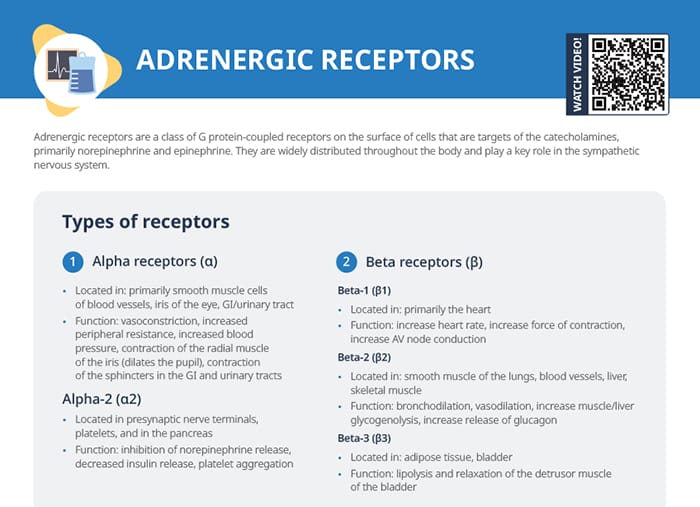What are adrenergic receptors?
Adrenergic receptors are a class of G protein-coupled receptors on the surface of cells that are targets of the catecholamines, primarily norepinephrine and epinephrine. They are widely distributed throughout the body and play a key role in the sympathetic nervous system.
Related videos
Alpha adrenergic receptors
Alpha-1 adrenergic receptors (α1)
Alpha-1 receptors (α1) are primarily located in the smooth muscle cells of blood vessels, the iris of the eye, and the GI/urinary tract.
Functions:
- Vasoconstriction
- Increased peripheral resistance
- Increased blood pressure
- Contraction of the radial muscle of the iris (dilates the pupil)
- Contraction of the sphincters in the GI and urinary tracts
Alpha-2 adrenergic receptors (α2)
Alpha-2 receptors (α2) are primarily located in presynaptic nerve terminals, platelets, and in the pancreas.
Functions:
- Inhibition of norepinephrine release
- Decreased insulin release
- Platelet aggregation
Beta adrenergic receptors
Beta-1 adrenergic receptors (β1)
Beta-1 (β1) receptors are primarily located in the heart.
Functions:
- Increase heart rate
- Increase force of contraction
- Increase AV node conduction
Beta-2 adrenergic receptors (β2)
Beta-2 (β2) receptors are primarily located in the smooth muscle of the lungs, blood vessels, liver, and skeletal muscle.
Functions:
- Bronchodilation
- Vasodilation
- Increase muscle/liver glycogenolysis
- Increase release of glucagon
Beta-3 adrenergic receptors (β3)
Beta-3 (β3) receptors are primarily located in adipose tissue and the bladder.
Their function is lipolysis and relaxation of the detrusor muscle of the bladder.
Medications to promote or counter effects
Alpha agonists
Alpha agonists promote the effect of α receptors. Examples:
- Phenylephrine (α1) for nasal congestion and hypotension
- Clonidine (α2) for hypertension
Nursing interventions include monitoring blood pressure and watching for signs of excessive vasoconstriction or vasodilation.
Alpha antagonists
Alpha antagonists counter the effect of α receptors. Examples:
- Prazosin (α1) for hypertension and benign prostatic hyperplasia
- Phentolamine (α1 and α2) for hypertensive emergencies
Nursing interventions include monitoring blood pressure and watching for signs of excessive vasoconstriction or vasodilation.
Beta agonists
Alpha agonists promote the effect of β receptors. Examples:
- Isoproterenol for bradycardia and heart block
- Dobutamine (β1) for heart failure
- Albuterol (β2) for asthma and COPD
Nursing interventions include monitoring heart rate and blood pressure and assessing for hyperglycemia.
Beta antagonists
Alpha antagonists counter the effect of β receptors. Examples:
- Propranolol for hypertension and arrhythmias
- Metoprolol (β1) for hypertension and heart failure
- Labetalol for hypertension and hypertensive emergencies
Nursing interventions include:
- Monitoring heart rate and blood pressure (regularly check for bradycardia and hypotension)
- Adjusting dosages based on therapeutic response and side effects like fatigue, dizziness, or heart block
- Assessing for bronchoconstriction
- Monitoring blood glucose levels

